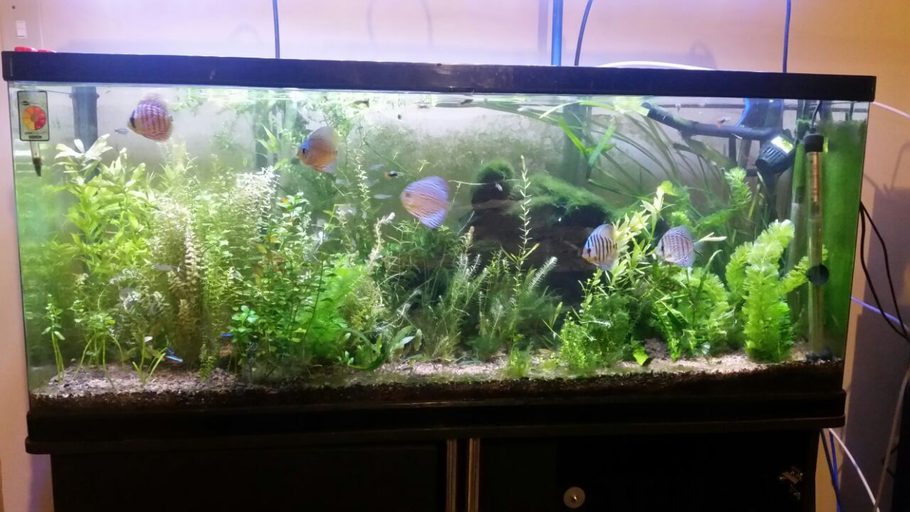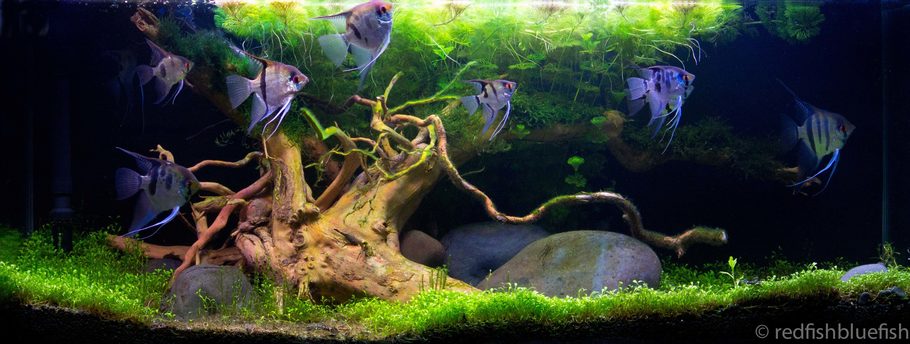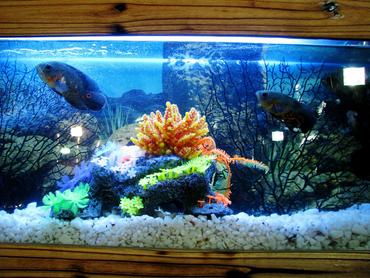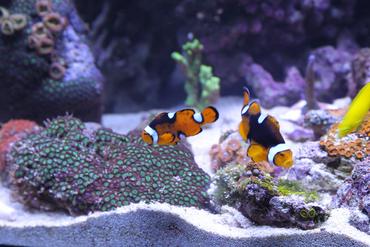SPRING CLEANING: HOW TO CLEAN AND GIVE YOUR OLD TANK NEW LIFE

Updated
Keeping your tank clean is about more than just aesthetics - it also affects your fish. Keep reading to learn how to spring clean your aquarium.
Over the winter, it is easy to just hunker down and do everything you can to stay warm. While you can’t escape responsibilities like work or family obligations, certain things are likely to fall to the wayside – your fish tank included. With spring on the horizon, you are finally coming out of hibernation and it’s time to survey the damage.
While a properly equipped fish tank can do perfectly well with minimal maintenance, months of neglect will eventually take their toll. Your crystal-clear water will start to cloud, your tank decorations will begin to accumulate algae, and even your tank walls might develop a film. As you start spring-cleaning your home, make sure to add cleaning your fish tank to your to-do list.
As is true for most things, there is a right way and a wrong way to deep-clean your tank, so keep reading to learn how to do it properly. In this article, you’ll also receive some tips for updating your tank to give it new life in preparation for spring as well as some tips for long-term maintenance.
A Word of Precaution Before You Begin
If you need to deep-clean your fish tank, your first instinct might be to drain all the water and give everything a good rinse. While that is certainly one way to do it, it is also the wrong way. If you completely tear down your tank all at once and give everything a good scrub, you’ll be scrubbing away more than algae and grime – you’ll also be wiping out your entire colony of beneficial bacteria.
Though you cannot see them, the beneficial bacteria in your tank are constantly working to maintain balance. They facilitate the breakdown of waste products such as uneaten fish food, fish feces, and decaying plant matter. As these wastes break down, ammonia is produced as a byproduct and it can be extremely toxic to your fish. Fortunately, those beneficial bacteria take that ammonia and convert it into less harmful substances through a multi-stage process.

What you need to remember is that even the final product of biological filtration can still be dangerous to your fish in high concentrations – that is why routine water changes are so important! Your beneficial bacteria can only do so much. It is still up to you to physically remove the toxic chemicals from the tank by replacing a portion of your dirty tank water with fresh water each week.
If you’ve neglected your water changes for weeks or months on end, you may think that changing all of the water in the tank at once is the solution, but you would be wrong. Changing too much of your tank water at once can not only be shocking to your fish, but it could kill off your beneficial bacteria. So, what’s the solution? Keep reading to receive a step-by-step guide for deep-cleaning your tank without endangering your fish or causing it to re-cycle.
Step-by-Step Guide for Deep-Cleaning a Dirty Fish Tank
Before you settle in to give your tank a much-needed cleaning, you’ll need to gather up a few supplies. You’ll want to stock up on supplies to scrape algae, first and foremost – an abrasive pad, a razor blade, and plenty of rags will do nicely. Add a gravel vacuum (water siphon) to your list as well as a large bucket or two, an assortment of brushes, some aquarium-approved glass cleaner, and some bleach. Once you’ve gathered your supplies, here’s what to do:
1. Start by giving the glass a good scrub.
Take your abrasive pad or algae pad and go over the glass inside the tank. Depending on the size of your tank, you may need to purchase a long-handle scrubber or just settle for getting your arm wet. Though you might be able to get away with a regular household scrubbing sponge, it’s safer to purchase an algae pad from a pet store just to make sure they don’t have any cleansing agents or chemical residue on them. These things don’t matter for kitchen clean-up but they could harm your fish.
Once you’ve gotten rid of most of the algae with the scrubber, use the razor blade to scrape away any tough algae that remains. As a word of caution, only use a metal razor blade on glass tanks – for acrylic tanks, go with a plastic blade instead.
2. Scrub and soak tank decorations.
After you’ve cleaned the glass in your tank, remove the decorations and give them a good scrub as well. Be sure to empty the tank of everything that isn’t permanent – this includes rocks, novelty décor items, and even fake plants. Use your algae scraper again to clean these things as well as you can, paying close attention to the leaves of your artificial plants to remove as much algae as you can.
If your tank décor is particularly dirty and the scrubber isn’t working, you might have to resort to soaking your décor items in a bleach solution. Fill your sink with a 10% bleach solution and soak everything for 15 minutes. After soaking, try scrubbing the items again and then rinse well in running water to remove all traces of bleach. Once everything has been rinsed, set it out to air dry so any residual bleach will evaporate from the surface.
So, what about live plants? Even living plants can accumulate algae and you want to get rid of it before you put them back in your tank. Many plants will tolerate a short soak in a 5% bleach solution, but don’t leave them in for more than 2 to 3 minutes and then rinse them very well. Keep in mind that stem plants may not tolerate bleach as well, so test the solution on one plant before you soak them all.

3. Siphon your substrate.
While your tank decorations are air-drying, now it’s time to siphon the substrate. All of the algae you scrubbed off the walls should have had time to settle so now it’s time to get rid of it. Take your gravel vacuum and create a siphon, placing the large end of the tube in your tank and the smaller end in a large bucket. If your tank is close to a sink, even better – otherwise, you’ll have to keep an eye on the bucket and empty it once in a while, so it doesn’t overflow.
As you siphon your substrate, work in sections so you don’t stir up too much of the debris into the water. Position the open end of the siphon above your substrate and push it all the way through to the bottom of the tank. Move the siphon slowly to collect as much accumulated debris as you can. Prepare yourself, because it could be an unpleasant sight! If you haven’t kept up with tank maintenance lately, there is probably a significant amount of debris down there so the water coming up through the tube could be very dark and dirty.
Keep siphoning the substrate until the water runs fairly clear. Keep an eye on the water level in the tank, however, to make sure you aren’t emptying more than 50% of the total tank volume. If you have a small tank with a lot of accumulated debris, you might have to stop after siphoning half the tank then refill the tank with clean, dechlorinated water and wait a week or so before finishing the job.
4. Clean the outside of the tank.
Now that you’ve done the dirty work (literally), it’s time to clean the outside of your tank. After all, what good is it if the inside of your tank is clean but the outside is covered in dust and water spots? Check your local pet store for an aquarium-safe cleaner or just use a vinegar-and-water solution. Wipe down all of the external surfaces of your tank and wipe away the extra cleaner with paper towels or a clean rag. Don’t forget to wipe down your tank hood, light fixture, and any other external equipment that has probably been sitting and accumulating dust.
5. Wait two weeks then clean the filter.
The last step for deep-cleaning your tank is to clean your filter and renew your filter media. Unfortunately, you could end up killing most of your beneficial bacteria if you do it on the same day you siphon your tank substrate. So, put everything back in your tank and refill it with fresh, dechlorinated water. Make an effort to refill the tank with water the same temperature as the water in the tank to avoid shocking your fish or simply add the water slowly so they can acclimate to the change.
After two weeks, you can finally give your tank filter a little love – but should you just clean it and keep your filter media to avoid killing off beneficial bacteria, or should you replace it entirely? There are differing opinions on the matter, so it’s up to you which option you choose. Generally speaking, however, filter media that contains activated carbon, ion-exchange resins, or ammonia absorbers should be replaced completely every three weeks. Mechanical filter media like sponges, ceramic balls or rings, and filter fiber can be rinsed to remove accumulated debris and then returned to the filter.
The process outlined above may take you a couple of hours, but it will be well worth-it in the end when you see how much better your tank looks. You may also notice an improvement in your fish. Unfortunately, it isn’t always obvious when your fish are sick or struggling – you may only notice a decrease in appetite or activity as well as subtle changes in behavior. So, don’t be surprised if your fish become hungrier and more active once they start to benefit from the improved conditions in your tank.

Tips for Updating an Old Fish Tank
Once your tank has been deep-cleaned, it’s probably looking pretty good – but it could look better. While you’re at it, you might want to consider giving your tank a bit of a spruce-up with some updated décor, some live plants, and maybe a new arrangement. Here are some other simple ideas for giving your old tank a new look:
1. Swap out your artificial plants for live plants. There is simply no replacement for live plants – they look better than fake, and they actually benefit your fish by converting carbon dioxide waste into breathable oxygen. You may want to start with just one or two plants before transitioning into a fully planted tank, but even that simple addition can make a difference.
2. Change up your substrate. If you’re going to be adding live plants to your tank, you might need to change your substrate anyway. If not, making this simple change could also completely alter the look of your aquarium. Go with something bold and bright like colored gravel or glass stones. Another option is to go for a more natural look with white sand or fine gravel. You can also mix and match in layers for a truly unique look.
3. Add some new accessories. Part of the fun of having a fish tank is decorating it, so go wild with novelty decorations and give your tank a theme! You can find everything from sunken pirate ships to ancient ruins, underwater volcanos, and much more at your local pet store or online. If you’re smart, you’ll choose décor that serves a purpose as well – build a cave out of stones for your fish to explore or group decorations and plants together to create a hideaway for shy fish.
4. Install a 3-D background (or build your own). Many aquarium hobbyists simply cover the back of their tank with dark paper or maybe a picture of some underwater scene. Having a tank background hides those unsightly cords from view and enhances the aesthetics of your tank. If you install a 3-D background, however, it could do even more than that. A 3-dimensional background offers a textured surface for your fish to explore and it also provides additional surfaces on which beneficial bacteria can grow. Plus, it creates a much more natural look, if that’s what you’re going for.
5. Change the lighting. When you do all that work to clean and update your tank, you want to show it off! The best way to do that is to upgrade your lighting. If your tank lighting is outdated, swap it out for something new like LEDs – they are inexpensive, highly efficient, and they don’t produce heat. You can even find LED fixtures equipped with both daylight and lunar bulbs, so you can transition from bright light during the day to a soft, moonlit glow at night.
Updating an old tank doesn’t take as much as you might imagine – a few simple changes can make a big difference. Before you start, just take some time to think about what you want your tank to look like and then hit the pet store for supplies and inspiration. Even if you think you know what you want to do, there is no harm in making one change at a time to see how you like it before you go making major changes. Just use your creativity and do what you like!

Maintenance Tips to Keep Your Tank Clean
Now that you’ve done the work to clean and update your tank, you want to maintain your results! If you did absolutely nothing, your tank might stay relatively clean for a few months but eventually you’ll start to see the algae and grime slowly creeping back in. You could just let it go, but then you’d have wasted all that time and you’ll just have to do it again.
Fortunately, keeping your tank clean isn’t as difficult or as time-consuming as you might imagine. In fact, it just takes a few minutes per day or about an hour a week. Here’s what you need to do:
- Once a week, take your algae scrubber or razor blade and remove any algae from the walls of the tank. Don’t worry, your filter will pick it up and remove it from the water column.
- Perform a 10% to 15% water change once a week, using a gravel vacuum to remove dirty water and debris from the substrate in your tank. You may want to focus on one section each week to avoid removing too much beneficial bacteria at once.
- Check your decorations and plants for algae and give them a quick scrub and rinse as needed once every week or two.
- Clean your filter once a month and rinse or replace the filter media, if needed. Remember, chemical filter media should generally be replaced every three to four weeks while mechanical media can be rinsed and returned.
- Wipe down the outside of your tank as well as any external equipment once a week to remove dust and water spots.
- Soak your fishnets at least once a month in a disinfectant solution so they are clean and safe the next time you need to use them.
Maintaining a clean and thriving aquarium is more than just a hobby – it is a matter of pride. Not only do you want your tank to look great for your houseguests (and for yourself), but you should also make it a priority to keep it clean for the wellbeing of your tank inhabitants.
So, take the time to clean out all of the muck and grime then make a few updates to breathe new life into your old tank. From there, simply follow the maintenance tips provided above to keep your tank clean and clear for the long haul.
comments powered by Disqus
MOST RECENT ARTICLES

During the summer months, it may become more of a challenge to keep your aquarium temperature stable.

There are many different species of barbs but some of them are better than others for the larger home aquarium.



















